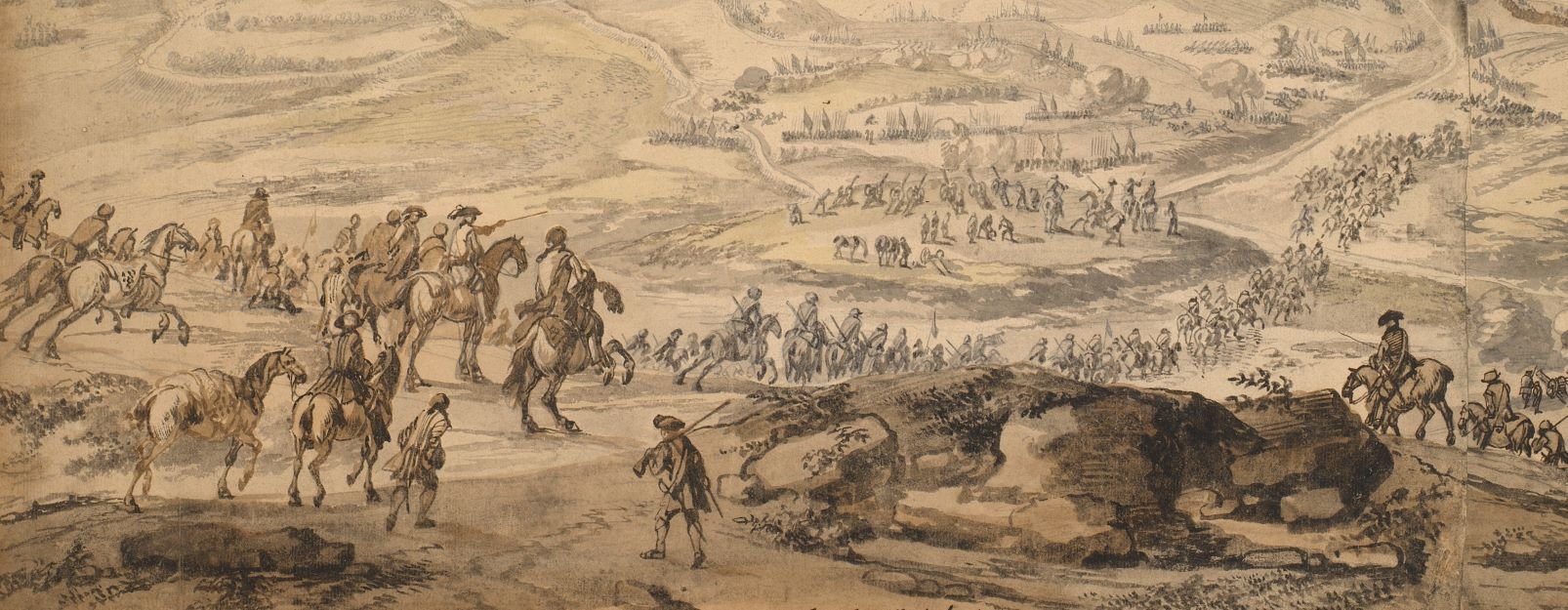
Printed and manuscript maps, prints and views of 22 seventeenth-century wars
Map of the siege of Maastricht, 1673 (Maastricht, Limburg, Netherlands) 50°50'54"N 05°41'20"E
1673 or laterEtching and engraving; printed on paper; no gilt edges | Scale: not stated | RCIN 724004
The date in the title is faintly printed.
The line of circumvallation passes through the following settlements: the temporary fort on ‘Monte Dousberg’ (now in the centre of the Maastricht International Golf complex); Haren (probably Borgharen 50°52ʹ39ʺN 05°41ʹ15ʺE); Mersenhoue (Meerssenhove 50°53ʹ00ʺN 05°43ʹ00ʺE); Limme (Limmel 50°52ʹ02ʺN 05°42ʹ26ʺE); Ambi (Amby 50°51ʹ44ʺN 05°43ʹ56ʺE); Brwyst (probably Bruisterbosch 50°48ʹ21ʺN 05°48ʹ10ʺE) and Gronsfelt (Gronsveld 50°48ʹ39ʺN 05°43ʹ50ʺE). The settlement of ‘Nay’, on the west bank of the Moselle is possibly Lanaye (50°46ʹ45ʺN 05°41ʹ46ʺE).
The massed artillery fire at three hornworks on the west side of the city and the exploding mortar bombs, with their arched trajectories, are shown to devastating effect in the inner city. This was the first siege conducted by Vauban who used his design of parallel trenches here for the first time (parallel trenches are reputed to have first been used by the Turks during their long siege of Candia, 1648-69, the Turks, in turn, had taken the method from an Italian engineer.) This is the action in which Charles de Batz-Castelmore d'Artagnan (c.1611-73), captain of the Musketeers of the Guard – the legendary d'Artagnan made famous by Dumas – was killed.
Additional text: [left, in rectangular panel, a key, A-I, K-T, to the lines of circumvallation, the trenches and batteries with the number of cannon in each, the fort of St Peter, the mortar bomb emplacements, a boat bridge and the various quarters of the commanding officers.]
Condition: one fold line; slightly creased. Verso: some brown staining; faint ink blotches.
François Collignon (c.1610-87) (printer) [bottom left, inside neatline:] Si Stampa in Roma da fran.co Collignon nel Parione con licenza de Sup.ri
Subject(s)
Army-FranceWatermark: Fleur-de-lys in circle
Condition: one fold line; slightly creased. Verso: some brown staining; faint ink blotches
Scale: not stated
29.2 x 43.6 cm (neatline)
30.4 x 43.6 cm (image)
34.4 x 47.6 cm (sheet)
35.7 x 43.7 cm (platemark
Printed title:
PIANTA DELLA CITTÁ DI MASTRICH 1673 / Gia Assediata li ij. Giugno dal Rè Christianiss.o LVDOVICO XIV. / e presa alli 30. del detto [top centre]
Additional text:
[left, in rectangular panel, a key, A-I, K-T, to the lines of circumvallation, the trenches and batteries with the number of cannon in each, the fort of St Peter, the mortar bomb emplacements, a boat bridge and the various quarters of the commanding officers.]
Annotations:
George III heading: Maestricht 11-30 June 1673.
Other annotations: none.
George III catalogue entry:
Maestricht Pianta della Citta di Mastrich assediata dal Re Ludovico XIV li 17 e presa alli 30 Giugno 1673: da F. Collignon.
Subject(s)
Maastricht, Limburg, Netherlands (50°50'54"N 05°41'20"E)
Bibliographic reference(s)
J. Ostwald, Vauban under siege: engineering efficiency and martial vigour in the War of the Spanish Succession, Leiden 2007, pp. 57-8
Voltaire; M. P. Pollack (translator) and F.C. Green (ed), The age of Louis XIV, London 1926, reprinted 1969, p. 89
Page revisions
3 November 2024
Current version






